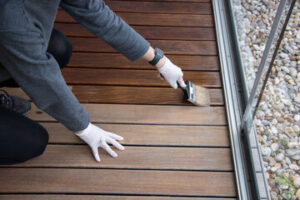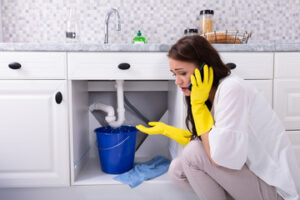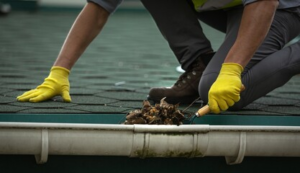Hardwood Floor Refinishing Bergen County NJ is a great way to breathe new life into hardwood floors. It involves sanding down the surface to remove deep scratches, dents, and old finish and then applying a fresh coat of stain.

Before the refinishing process begins, it’s essential to clear out the room of all furniture and items that could get in the way. This will help to ensure that the process is completed without any issues.
This process removes the top layer of damaged wood, leaving a pristine surface that can then be stained or sealed according to your personal taste. Floor sanding is a time-consuming job that can take four to seven days, depending on the size of your home. During this time, you’ll have to stay out of the house, but if your floors are in need of a serious facelift, it’s definitely worth it.
Before beginning this process, it’s important to remove any furniture from the room. This will prevent dust from getting into air ducts and blowing throughout your home. It’s also important to turn off your HVAC system and cover any vents in the room. Once the furniture is removed, begin by sanding the flooring with a large drum sander. Start with a coarse grit, such as 60, and then progress to a finer grit, such as 100. It’s best to sand in the direction of the grain.
Next, clean the surface of the hardwood with a cleaning solution or hot water and bleach mixture. You’ll need to be careful and follow the manufacturer’s instructions for the cleaning product you choose. When the cleaning is done and the floor is completely dry, it’s time to stain the wood. It’s important to apply the stain in thin coats and work in small sections of the room. This will help ensure a consistent color throughout the entire floor.
Staining your hardwood floors can be a tricky task, especially if you don’t know the type of wood your floor is made from. Different types of wood react to stains differently, so it’s crucial that you test your stain in an inconspicuous area before applying it to the rest of your floor.
After the staining is complete, it’s time to seal the floor. The sealant should be a polyurethane, and it can take one to two days to dry. Once the floor is fully dried, you can reinstall the baseboards and furniture and start enjoying your beautiful hardwood floors! Hardwood floors can significantly increase the value of your home, so it’s important to care for them properly. Regular upkeep of your floors will reduce the need for refinishing or even resurfacing and will keep them looking like new.
Staining
Staining can be an essential part of refinishing your hardwood floors. It adds color and a glossy sheen to the wood, making it look new again. It can also hide dents and scratches on the floor. Choosing the right stain can be difficult and time consuming, but it is important to get it right. It’s not like painting, where a mistake can be easily fixed, but staining is permanent.
Stains come in a variety of colors, and you should choose one that complements the color scheme of your home and matches other wooden elements such as furniture. You should test the stain in an inconspicuous area of the floor before applying it to the entire room. The color you test will never exactly match the final product, but it will give you a good idea of what to expect.
After the stain has dried, a skim coat of varnish is applied to protect it from damage. This is the last step before your floor looks brand-new again. This process can be tricky, as different woods react to stains differently, and it can be hard to achieve a consistent finish. You may need to sand and apply another layer of varnish two or three times before you get the perfect result.
When refinishing your hardwood floors, it is important to work in small sections and follow the grain of the wood. This will prevent overlapping and uneven color. Make sure to use purified or distilled water when preparing the floor for staining, as chlorine and other chemicals can alter the appearance of the stain.
Once the stain has dried, it is time to apply a coat of polyurethane. It is best to use a foam roller and a lamb’s wool applicator pad. It is recommended to let the polyurethane dry for 24 hours before resuming normal household activities. It is crucial to wait this long, as walking on a newly-sealed floor can cause dents and scratches. You should also avoid using abrasive cleaners on your floor until the polyurethane has fully cured. This can take several days.
Sealing
Unlike cheaper alternatives that may require replacement as soon as they show signs of wear, hardwood floors are a beautiful investment that can last a lifetime with proper care. One of the most important steps in extending the lifespan of your flooring is sealing, which protects your hardwood floors from water damage, dirt, and grime. Sealing can also help to preserve the color and sheen of your hardwood floors.
To ensure a quality result, the best time to perform this step is after your floor has been sanded and stained. The process is incredibly messy, and although professional refinishers have containment systems in place, it’s generally a good idea to take precautions by placing down tarps or removing furniture and other items from the room ahead of time. Vacuum and sweep the area to remove sawdust, grit, and other debris. Be sure to use a vacuum with a HEPA filter to avoid breathing in the dust. After sweeping, a tack cloth can be used to remove any remaining particles and ensure the surface of your flooring is free of dirt, grit, or residue.
A high-quality polyurethane sealant will help to protect your flooring from moisture and damage, as well as prevent the color of your hardwood flooring from fading over time. It’s a good idea to read the manufacturer’s instructions for application, drying times, and coverage. The first coat of sealant should be applied to a clean, dry surface with a brush or foam applicator pad. Once the first coat has been allowed to dry, sand the wood with a fine sandpaper – usually #220 sandpaper – to prepare the surface for the second and final coat of sealant.
Properly maintained hardwood floors are a great way to add value to your home and can increase its resale price. However, if your hardwood flooring is damaged or has an unappealing finish, you may be in need of refinishing. Whether you want to restore your old hardwoods or you’re looking for a new look, refinishing is an affordable and effective option. Refinishing is more expensive than purchasing and installing a new hardwood floor, but it’s much less costly than replacing or repairing hardwood that has been damaged by water.
Buffing
Buffing is a crucial step between the coarse and fine sanding processes and the application of your chosen finish. It also serves as an effective way to remove scratches and scuff marks from wood floors, as well as smoothing the surface for better absorption of subsequent treatments or coatings.
Professionals utilize a special buffing machine fitted with a specialized abrasive pad to achieve this effect. They will typically wear protective gear such as a face mask to protect themselves from the dust that will likely be generated by this process.
Before the floor is buffed, it must be thoroughly cleaned to remove any dust and debris. If this isn’t done, the buffer will likely scuff the furniture and cause uneven results. The floor should also be thoroughly dried before the buffing begins.
To achieve the best possible result, buffing should be performed at a consistent speed. This will ensure that all areas are treated equally, and that no swirl marks are created. It is also a good idea to overlap passes slightly. In addition, it is important to regularly replace the abrasive pads as they wear down to prevent any scratching.
A final buffing with a very fine abrasive can help to improve the look of the floor and ensure that it is ready for a new coat of finish or sealant. This can help to create a shiny, reflective surface that is resistant to stains.
If you’re not happy with the appearance of your hardwood floors, it might be time to hire a professional to do a buff and coat. This process can restore your floors to their original beauty and give them the added protection that they need.
However, it’s important to remember that a buff and coat will not be able to lift deep scratches that have penetrated the thin layer of polyurethane on top of the timber. It will also not be able to remove water stains or traffic patterns – dry/gray areas of the floor where the finish has worn away. If you’re concerned that your floors are displaying these kinds of signs, it might be time to consider a full sand and refinish instead.

